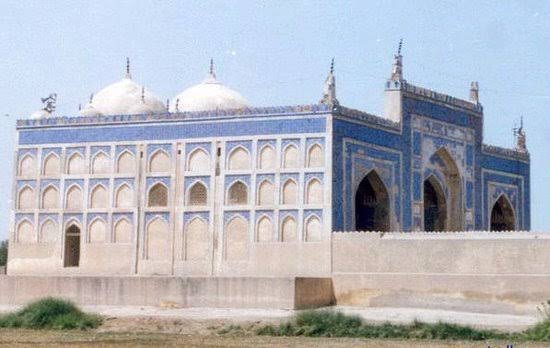Khudabad

Compiled By: Rtn. Gangaram Shamdas Purswani (P.H.F.)
Khudabadi Sonara Community FOUNDED Khudabad. Some families of Khudabadi Sonara Community settled on an “empty land” on the banks of Sindhu River, near Dadu, in Sindh, after returning from Kutch around 1351. The families of Khudabadi Sonara Community developed the empty land on the banks of the Sindhu River and named it Khud-Abad (Selve Developed). This development drew the attention of other Sindhi communities and started to settle there. The rapid growth of the town came into the knowledge of the Governor of Sindh, Miya Yaar Mohammed of the Kalhora Dynasty.
Miya Yaar Mohammed Kalhora, when he was in power, around 1710, with the help of his followers, won over Khud-Abad from the Panohar Muslims. Between 1718 and 1719, Miya Yaar Mohammed Kalhora died and he was laid to rest there. Miya Noor Mohammed Kalhora, who became the ruler of Sindh (1720-1755), then, chose Khud-Abad as his capital. The choice of Khudabad as the capital of Sindh glorified the Khudabadi Sonara Community. Miya Noor Mohammed Kalhora rapidly, started developing the place as a well planned city, which led to many Amils and Bhaibands migrating there for employment and trade.
Most of Khudabadi Sonara in Khudabad, used to supply their gold ornaments products to Seth Sawanmal (non Khudabadi Sonara), due to favourable terms of payment and logistic facilities. He was a very prosperous jeweler and trader. He had business interest in Khudabad old Sukhur, Kotri, Thatta and Keti Bunder, all of them were important trading centers of Sindh in those days. Seth Sanwalmal was Suryavanshi, Sindhi lohana and his ancestor “Rajmal” fought for Raja Daharsen, during the year 711 Arab invasions and laid down his life. His children along with other Hindus left Sindh for safer grounds, after the battle was lost. After time immemorial, they returned to Sindh during Kalhora reign and lived in Khudabad. Seth Sanwalmal died in 1773, leaving behind his four sons, Chhatomal, Lakhimal, Bharomal and Tolomal. The descendents of Bharomal and Lakhimal are now known as Bharvani and Lakhiani respectively.
Due to Muslim domination, the “Khud-Abad” was renamed as “Khudabad” a Muslim name. A railway station with the name “Khudabad” was also built on the railway line between Sehwan and Dadu about eleven kilometers south of the later. Miya Noor Mohammed. Kalhora built a massive Jamia Masjid near the Railway Station and appointed one Mullaha to look after the Jamia Masjid and paid Rs. 5/- per month to him.
In 1755, Mia Noor Mohammad died and was buried in a Tomb, built by him before his death, about a kilometer from Khudabad City. In early nineties, a Mujwar was appointed to take care of the Tomb and to keep a light burning daily and was paid Rs. 3/- per month. It is said that Miya Yaar Mohammad Kolhora used clubs (wooden thick sticks) to win over Khu-Abad from Panohar Muslims. Those clubs have been kept in the same Tomb. People used to come to Tomb for worship and offer sticks as symbols of respect. Many a times, Hindus perform Mudan ceremony of their children there and offer sticks as rituals.
With lot of development and business, the residents of Khudabad City became very rich. It is said that people still find very old coins in the ruins of Khudabad City. Around the year 1908, one charcoal seller and blacksmith were riding of on a pony. The pony fell down and collided with a wall of an old building. The wall collapsed and some golden coins fell down. With the help of some labourers they found many gold coins which they kept with them.Later on, this secret was leaked out and they were charged under” Indian Treasure-Trove Act” in the court of Resident Magistrate of Dadu where they deposited a few coins and rest were hidden by them.
Miya Noor Mohammed Kalhora died in the year 1755, and was buried in a tomb (built by him before his death), about a kilometer from the Khudabad City. After that, Miya Ghulam Shah Kalhora’s claim to rule was challenged by his brothers Ahmedyar Khan and Attar Khan. The latter was able to obtain Sanad (Authority to rule) from Ahmed Shah Durani and therefore Ghulam Shah vacated the seat in his favour, Miya Attar Khan could not manage the state of affairs. Taking advantage of uncertainty, Khosas (a caste in Muslims) looted Hindus and Muslims and burnt the Khudabad city down. Therefore, in the year 1759, the Baloach Chiefs re-invented Miya Ghulam Shah Kalhora, who defeated his two brothers and assumed the throne. He, commendably, re-developed the city of Khudabad at nearby lands; on the banks of the river Sindhu. The Kalhora Dynasty ruled Sindh for 85 years (1698-1783). Twelve Kalhora rulers ruled during this period, which is known as the golden period of Sindhi Literature. Poets like Shah Abdul Latif Bhitai, Sachal Sarmast and Sami are among the prominent poets of Sindh, who were there, during that period.
Fateh Ali Khan (Talpur) defeated the Kalhoras in 1783 and took over as the new ruler of Sindh. Khudabad City continued to remain his capital of Sindh till it was inundated by river Sindhu in the year1789 and then Mir Fateh Ali Khan chose Hyderabad (Nayrun Kot) as his capital. The change of capital no doubt induced a large number of the population of Khudabad to migrate to the new seat of royalty and Khudabad City’s decline may be said to have commenced from that date.–